News
Animation in film
3rd November, 2020
Animation on the silver screen.
Animated films are such a standard part of the movie industry now that it’s hard to imagine a time when they were a big deal simply by nature of being animated. Let’s pick up where we left off in the history of animation and look how and why it came to be a core part of film making.
After Snow White.
Despite approximately eight animated feature films being released before it, Disney’s Snow White and the Seven Dwarfs was the one that changed the game. Before its release, the upcoming movie was referred to as “Disney’s folly” but the creators successfully softened and moulded the traditional humour of animation into a magical experience which captivated audiences in the 1930s and continues to do so now.
Snow White showed that animation could offer more than slapstick and visual laughs; it could make people feel many more emotions and be used to tell deeper, more complex stories.
During the war.
Studios were forced to make cut backs during and after World War II simply to stay afloat. With Disney’s “Pinocchio” and “Fantasia” and Fleischer Studios’ “Mr Bug Goes To Town” all flopping at the box office due to difficulties getting them out to foreign markets, the industry had to reconsider animation, at least in the short term.
Most other studios chose to abandon their work on animated features but Disney opted to try a more economical style of animation and released Dumbo. Their creative thinking paid off and the loveable elephant brought in a profit at the box office.
Much like Disney, we’re big on out of the box thinking and determination when creating video.
While American cel-animated films dominated, countries like Russia, China and Japan worked on their own styles of animation. Although few of their works saw international success, they did receive recognition from within the film industry and inspired UPA animators to develop a much sparser and more stylised type of animation which earned Oscar nominations for their first two theatrical shorts.
Animation for adults.
It wasn’t until the late 1960s that animation expanded to reach adult audiences with A Boy Named Charlie Brown hitting cinemas in 1969. The philosophical, psychological, and sociological overtones of the Peanuts franchise made them enjoyable for kids and adults alike.
The anti-establishment counterculture boom quickly infiltrated Hollywood leading to several short underground films and parodies like Bambi meets Godzilla which is still considered a great classic among animation experts. At the same time, the popularity of psychedelia made the re-release of Disney’s Fantasia a hit with 60s teenagers and college students, finally making a profit nearly 30 years after the initial release.
On our side of the pond, The Beatles’ animated musical feature Yellow Submarine released to widespread acclaim from critics and audiences alike. It was so well received that Pixar co-founder, John Lasseter, has credited the film with bringing more interest in animation as a serious art form. It’s still regarded as a landmark of animation for showing a broad audience how animation could be quite different from the well known television cartoons and Disney features.
Pushing the boundaries.
Over the next few decades, animators and studios worked hard to push the boundaries of animation.
In 1972 Fritz the Cat became the first animated feature to receive an X-rating which was used to promote the film. It became the highest-grossing independent animated film of all time and inspired Bakshi to continue using animation to make political statements using an artistic blend of techniques and some live-action. The following year he became the second to have two financially successful animated feature films in a row when he released Heavy Traffic.

French/Czech science fiction production, La Planète sauvage, was awarded the Grand Prix special jury prize at the 1973 Cannes Film Festival. The imaginative film was also ranked the 36th-greatest animated movie ever by Rolling Stone in 2016.
Japan’s anime became a big part of the country’s mainstream culture and they embraced original video animation in a way not yet considered in the US where video was reserved for releases which were unlikely to be popular in cinemas or television. In 1985 Studio Ghibli was founded which went on to release some of the greatest animated films of all time.
As the 80s came to a close Disney and Pixar came together to create smash hit, The Little Mermaid, which included the first piece of feature animation to be created with the Computer Animation Production System system.
After the success of Pixar’s Toy Story in 1995, computer animation grew into the dominant animation technique in the US and many other countries. Even animation that looked traditional was more and more often created fully with computers. By 2004, only small productions were still created with traditional techniques.
The move to 3D.
In November 2004, The Polar Express became IMAX’s first full-length, animated 3D feature. The 3D version earned about 14 times as much per screen as the 2D version prompting a great interest in 3D animated films.

Visionary director, James Cameron, famously delayed work on Avatar from the 1990s until 2006 to allow technology to reach the necessary degree of advancement to adequately portray his vision of the film. His patience paid off and when Avatar premiered in December 2009 critics highly praised its ground-breaking visual effects. It broke several box office records and remains the second highest-grossing movie of all time when adjusted for inflation. It also became the first film to gross more than $2 billion and won three Oscars for Best Art Direction, Best Cinematography, and Best Visual Effects.
The power of animation.
At every stage of animation’s evolution its power is clearly demonstrated; the power to make people feel, to express complex concepts, and to connect people. Animation has so much to offer beyond the big screen too – brands can utilise all the benefits of animation on a smaller scale to create marketing magic in a digital world.
If our exploration of this incredible medium has sparked your interest, get in touch with our award winning animation team.
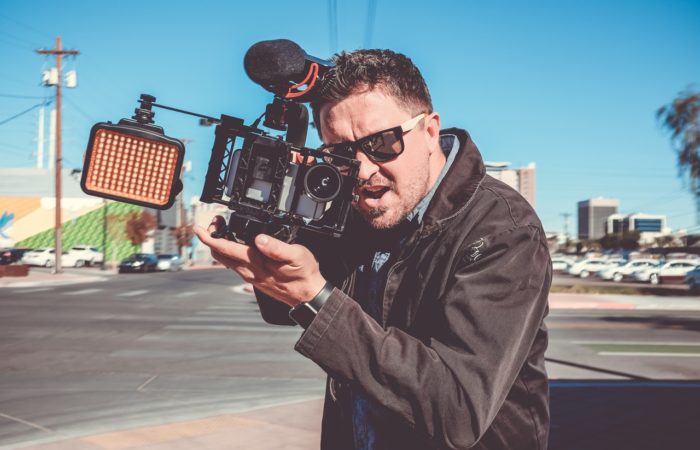
The video production process
6th July, 2020
The video production process explained!
With viewers retaining 95% of a message when they watch it in a video, compared to 10% when reading it in text, video is key to any marketing strategy so we want to walk you through the video production process so you know what to expect when working with a production company.
Whether you’re looking to increase brand awareness using social media (social video generates 1200% more shares than text and image content combined) or create a slamming marketing campaign that skyrockets sales, video content is the difference between mediocre and magnificent. So let’s get into the nitty gritty, how do you even make a video?
Planning is for pros
Getting clear on what you want to achieve with your video content and your overall campaign is essential. Standalone videos are powerful but for maximum effectiveness they need to be part of a cohesive marketing strategy.
The planning and pre-production stage is where you and your marketing team decide on the messaging, the feel, the call to action and every other part of the video. Getting this right at this stage saves time and money later on; do you really want to have to re-edit or reshoot an entire video because you forgot a key piece of information? We vote no!
You’ll also want to think about the delivery method for your video at this stage to ensure the final cut is optimised for whichever method you choose.
With your detailed brief in hand you can then move on to the next step, the thing most people think of when they think about video production, the actual production!
Production
You might be surprised to learn that this is usually the shortest part of the whole process but less surprised that it’s the most expensive!
Depending on the type of video you’re creating, costs can include videographers, directors, actors, travel and food, drone pilots, studio or location among other things. Don’t panic; a great brief helps to keep production costs down as the video production company knows exactly what they need to bring your vision to life.
Looking for a little behind the scenes peek at our own production process?
Post-production is an art
Everything that comes after Ben shouts “that’s a wrap” is post-production. This is the editing stage where the best shots are chosen and assembled into a rough cut. You can expect to see lots of cuts during this process as your editors work to ensure your message comes across clearly and the video looks just as you imagined.
As you work with your editor, you’ll notice they get to know the style you like and can start to predict which shots you’ll choose, this makes each rough cut quicker and closer to your vision than the last. They will also be able to offer you suggestions for edits that may not have been part of the original brief but that add to the aim of the video, the best video content allows for a little artistic license in post-production.
It’s from this main output that any shorter videos are created for social media, as teasers or as shorter ads once the campaign has kicked off.
Finishing
Once you’ve given the OK to a final arrangement of clips, any visual effects or other extras can be added. These are the flourishes that add a little extra sex appeal to your video. Once these are confirmed the video is considered “locked,” meaning no more edits will be made to the visuals.
Now all the other things that make your video stand out can be added such as colour grading, music or audio effects and sound levels. You’re so close to seeing the completed version and releasing it out into the world, the excitement is almost unbearable!
Congratulations; it’s a devilishly handsome video!
The final cut has arrived in your hands, now you just need to introduce it to your audience. Don’t worry, we still get nervous when it’s time for our baby to fly the nest but, if you’ve put in the planning time and worked with an amazing team, there’s really nothing to worry about… apart from ensuring the rest of your marketing materials support and enhance the incredible video you’ve just created.

How The Finance Sector Can Bring Marketing Videos To Life Using Drama
11th March, 2019
Finance is only sexy when you’re counting your millions, amirite?
But even the most hard-going, intricate and – dare we say it – dull subjects have the potential to be jazzed up using marketing videos. The key is in the “how?”. And the “how?” can often be answered with a big injection of drama.
Failing to see how you can turn your finance product or service into a dramatic cliff-hanger? Allow us to guide you…
Create and film a worst case scenario
When you think gripping, sexy drama, you don’t tend to think ‘business insurance’. Not as a face value product anyway. But what about the truly horrific consequences of needing business insurance? Now THAT is something that grabs attention.
Hiscox have done a truly incredible job of creating and filming something that their ideal customer never wants to have happen to them. Bringing that disaster to life before the customer’s very eyes is a surefire way to get their attention, allowing them to feel the full gravitas of a cyber attack without it having happen to them.
A few things we love about this video that makes it so very impactful include:
- The levelled-up messaging. It’s not about “buy our insurance because something bad could happen”. It’s about “this is what can happen when you don’t buy insurance, and this is how it feels”. They’ve turned their sales pitch into a no-brainer ultimatum by bringing a cyber attack to life.
- Letting the viewer connect with the video characters. Of course, there’s no time for a full background story and inner monologue cut to a montage. But we get little glimpses of the Brompton employees personalities that makes us like them – including being very caring and passionate about their job – and panic all the more when the hack begins.
- They used a British business we all know and love, rather than making up a brand. Quite the shortcut to our emotions.
- That MUSIC!
Flashmob mentality
When you think of the flash mob videos you’ve watched online, they tend to have two key ingredients that make them work:
- The spectacle – great dancing, exciting costumes, etc.
- The reactions of the unsuspecting bystanders.
Belgian TV channel TNT have taken the flash mob mentality and combined it with the Hiscox approach above, allowing the viewer to witness both the action and other people’s reaction to the action.
Whilst TNT might be playing in the fields of the entertainment industry, financial service businesses can take many tips from their approach:
- The joy of surprise – no one in that quiet, quaint little square was ready for what was about to happen.
- Immaculate execution – the actors and stunts involved were unbelievable, and keep the viewer (and indeed the real life audience) gripped for the whole length of the video.
- Humour – the stunts are awesome, but they’ve ticked the comedy checkbox by letting us laugh at the stunned crowd at frequent intervals.
- Timing – Hiscox had done very well by keeping their real world hack video to under three minutes. But this one delivers in 1 minute 46 seconds. Their video editor is worth their weight in gold…
Combine values
We worked with DS Virgin Racing a while back on a dramatic marketing video for the FIA Formula E London Races with two key objectives:
- Boost the #FanBoost potential of racing driver Sam Bird. If enough fans voted for Sam, he’d earn an extra speed boost on his car that he could use at any point in an upcoming race.
- Showcase the new UK themed bodywork on his Virgin car.
Because timeframe and turnaround was very short on this project, a large amount of the magic had to happen in post-production. Here, we not only took Sam’s car to electrifying new levels (literally) by “building” the car out of lightning bolts.
But the real trick we had up our sleeve was in the suspense of the video.
You can hear radio broadcasts throughout the video (a trick used by many action and horror films to set a scene without filming a significant part of the story) depicting, in worrying tones, a world population fit to bust, serious effects of global warming and strains on the environment. As the magical electric volts start to build, the broadcasts give way to news on electric cars… the saviour of the world.
At the height of the video, these give way again to news of Sam’s race victory, associating his electric car not just with winning the race and the positive feelings that provokes in his fans, but with a positive effect on a world we all worry about.
It’s triumphant. It’s emotive. It creates topical, positive associations with real-world news. And it was all done entirely in post-production.
Can this method be applied to a financial services video? You bet it can.
Celebrity endorsement
If your little black book is more prevalent than your creative prowess, this can absolutely work in your favour.
Celebrities and influencers can bring a super simple format to life in a marketing video, and there are few simpler or more popular formats than the “XYZ reads tweets” or “XYZ answers…”.
Wired, for example, had Jude Law and Natalie Portman answering the internet’s most commonly searched questions.
I mean, that’s practically an advert for SEO search, right? Dull. Except not, because of the personalities behind the answers and the comedy setup.
Aside from knowing that the searches are particularly interesting/bizarre, what truly makes this simple video work is the personality or personalities presenting it, which you have to select carefully. Establishing that chemistry is where the work really is on this one, but if you can make it work the results can be sensational.
Set a challenge
We’re back to hackers again!
A simple but very nice format for the less sexy subjects is to challenge someone to do what your service tries to prevent.
The video above is actually more of a documentary than a marketing video, but the concept is still great, and comes back to re-focusing on the worst-case scenario if your potential customers don’t purchase your product. The added layer to this particular format, of course, is highlighting exactly how easily a hack can take place. It’s truly fascinating and really puts the fear of God into a person who’s already worried about this kind of thing taking place.
Love one of these formats, but need some help bringing them to life for your own business? You know where to find us.
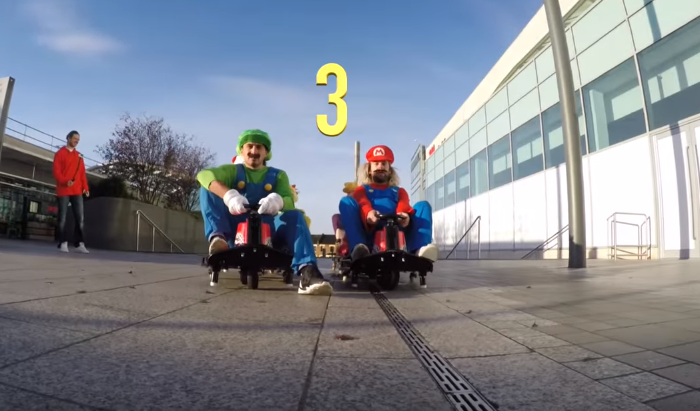
6 Crucial Viral Video Ingredients For The Tech Industry
25th February, 2019
Hands up who spent their childhood playing Mario Kart?
Of course you did. We all did. Mario Kart is one of the few things in the world that can be both nostalgic and timeless all at once, which is why it was the perfect subject for this viral video…
In a collaboration between stunt group Base37 and Go Pro, the group don go-karts dressed as Bowser, Peach, Luigi, Donkey Kong, Yoshi and Mario to re-enact the game’s famous ‘Coconut Mall’ race in real life.
The video garnered 1.4 million views in two days, making it a viral video sensation, with coverage on the Daily Mail and ITV News.
But what specifically was it about this video that paved the way for that ever-elusive viral success? Let’s take a look…
Humour
There are plenty of viral videos out there that are deadly serious (and rightly so) to raise awareness of a serious issue. But you’d only go down that route in the right situation and on morally sound grounds. Of course, promoting a camera isn’t going to fit that bill, so here we are. A bunch of millenials in full-size Mario Kart costumes doing something we’d ALL totally do, given the chance. It looks like so much fun, and the attention to detail with the game’s stunts are genius, like the banana throw at 1:15.
Simplicity
Complicated narratives do not a viral video make. Simplicity is a key factor in the quest for virality because you’re looking for mass appeal – that carries a requirement to hold people’s short attention spans. Ultimately, you need to make your audience think as little as possible.
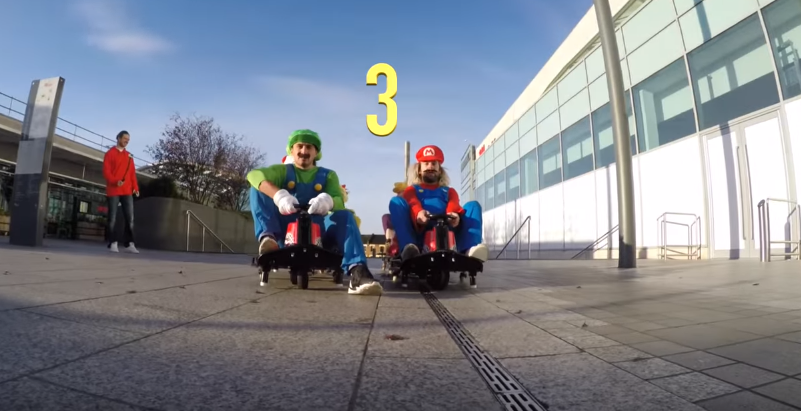
To be honest, this should be a leading point in any campaign you’re planning, video-based or otherwise. Overcomplicating a story or calls-to-action usually spell a death sentence for marketing success.
Surprise and delight
One of the things that strikes us as we watch the Mario Kart video back is how brave you’ve got to be to film this in the first place. Because this video definitely came with risks. On a basic level there’s simply being seen dressed as a Mario Kart character in public, which would wrack the nerves of many. Add to that the Go-Kart race in public and without the permission of the shopping mall, and you’ve got a never-ending risk assessment on your hands.
That said, those factors are what keeps the conversation going in the video comment. Just the idea that the group had the guts to go through with this becomes really topical – even creating speculation that the video was a fake (it wasn’t, by the way). This viral video ticked every box on the surprise and delight checklist, and became part of its overall success.
It’s short
There’s a time and a place for long-form video content, but when you’re competing for viral video fame it simply won’t fit the bill.
Short and snappy vids make shareable content. And in the infamous words of Bobby Womack: “Always leave them wanting more”.
Music
There’s an obvious win in the music stakes where a Mario Kart video is concerned – those Nintendo jingles are burnt into our memories forever (see also: the theme tune to The Flintstones and logging into MSN Messenger).
But as we’ve said before, music changes the pace and style of a video. Or sometimes, it can be a pronounced lack of music that really sets the tone. Either way, use sound cleverly and you’ve got another ingredient that works hard for you to help you on the way to viral success.
And finally, the unforgettable ending
Ok, it’s time to talk about that ending!
In this case it was the police catching up that makes this video unforgettable, and leaves one last hilarious joke with the viewer in the form of the Game Over screen and accompanying sound effect.
We’re not saying you should plan to take up valuable police time with the production of your next video. But we are saying that your next ending needs to stick in the mind of your audience for good reasons – with a clever joke, a big reveal, or an easy instruction that they just can’t ignore. Plan it carefully and viral video success is yours for the taking.
Want to chat about how we can help your next video be the one you’re remembered for? Drop us an email.
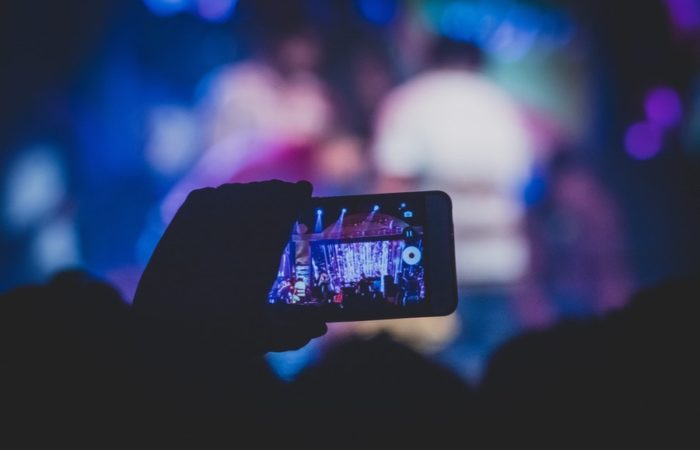
Video Marketing Tips For An IGTV Channel That Can’t Fail
25th February, 2019
Question: How much video marketing work have you been putting into your brand’s Instagram?
Lots, probably. Especially if your company is a very visually-led brand, or trying to reach a young audience demographic.
Next question: How much work have you been putting into IGTV?
If the answer to this is “minimal” or “what’s IGTV?”, these video marketing ideas for IGTV are going to be VERY useful to you.
Let’s start at the top.
What is IGTV?
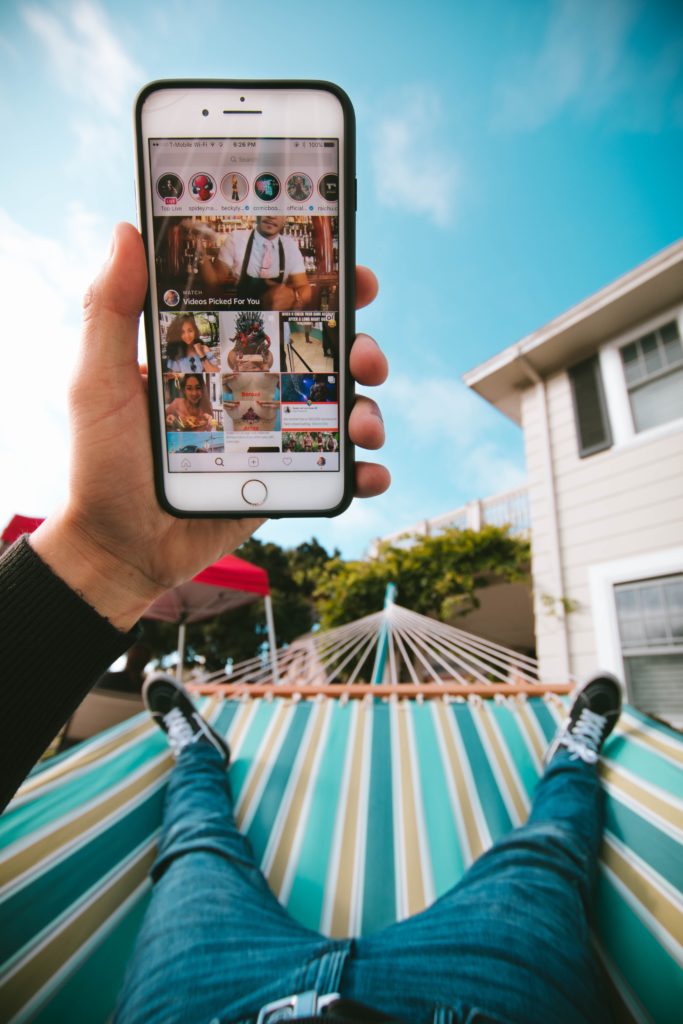
The official line from Instagram’s press site is:
“A new app for watching long-form, vertical video from your favourite Instagram creator. While there’s a stand-alone IGTV app, you’ll also be able to watch from within the Instagram app so the entire community of one billion can use it from the very start.”
Short and sweet answer: IGTV is an extension of Instagram that hosts videos up to 10 minutes in length.
What do I need to know before I use IGTV for video marketing?

When it comes to the ins and outs of using IGTV, we’ve read the manual for you (anytime, sweetcheeks) and pulled out the important tips for cracking on with Instagram’s latest toy:
- Unlike Instagram’s traditional interface, IGTV works very well on desktop as well as on mobile. You can even upload via instagram.com!
- You can’t just repost your Instagram Stories to this – they won’t show up when you go to upload from your camera roll and uploads must be at least 15 seconds long anyway. You also won’t be able to upload your previous live videos either – they’re really pushing for variety.
- Keep video titles short – they cut off around the 20 character mark.
- Influential accounts with very large followings can upload videos up to an hour (!) long.
- No subtitles required – unlike other social media platforms (particularly Facebook…), you don’t have to worry about viewers watching your material with the sound off. If they’re on IGTV, they’re prepared to listen, so think about what that initial audio is going to be.
- All URLs in any video description are clickable. Do you hear that sound? It’s the sound of being able to track direct Instagram referrals from an individual video. HALLELUJAH!
- Hashtags and comments work the same way they do on each IGTV video as they do on your main Instagram channel.
Video marketing strategy suggestions (that ANY brand can try!)
Conversations and interviews
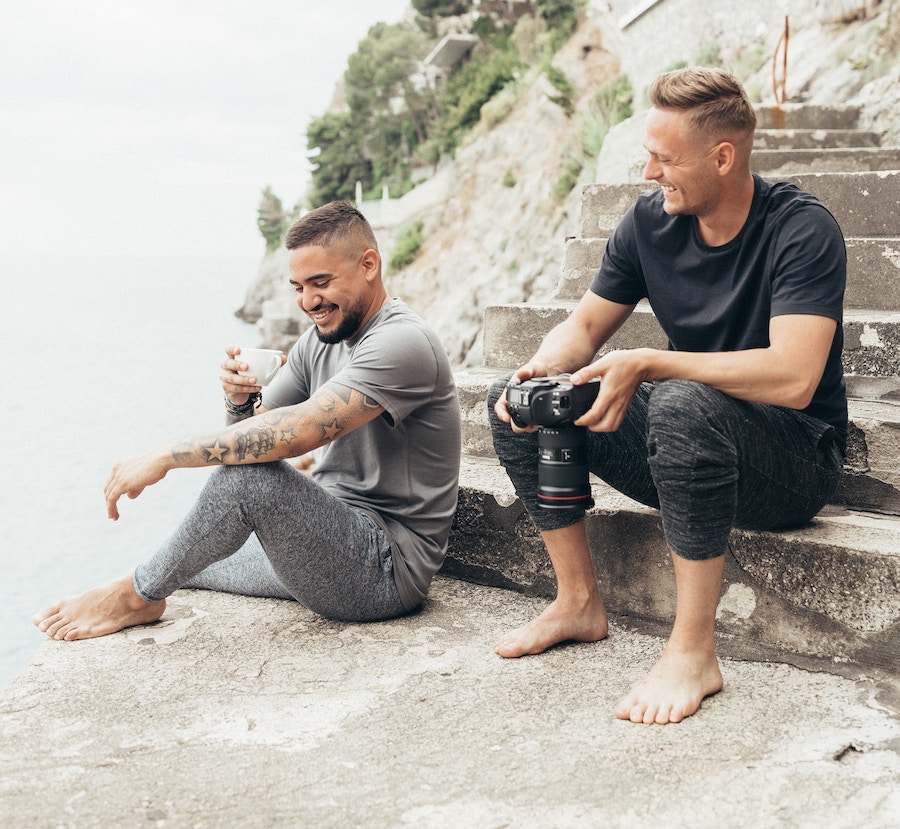
If you’ve tried to conduct a video interview via Instagram stories or Instagram Live, you’ll be all too familiar with the pitfalls. The former limits you to 15 seconds a time (impossible for any real depth), the latter of course poses a constant risk of things going awry that are completely out of your control (that said, Instagram Live is still a really engaging way to connect with your followers. It’s just that now IGTV is in the mix, you can try riskier creative ideas without any real… well… risk).
Snappy but uninterrupted interviews are now possible thanks to IGTV. So whether you’re keen to show off your team’s expertise by interviewing them or are working with an influencer who’s happy to spend some time on camera connecting with your audience, longer videos mean better, meaningful conversation. And goodness knows we could all do with a dose of that.
Tutorials and scripted videos

IGTV leaves you in the unique position that you don’t have to build your audience from the ground up – whoever follows your main Instagram is automatically following your IGTV too, they’re not separate. So, safe in the knowledge that your audience already know a certain amount about you and your product/service, start teaching them how it works!
Take them through filmed screens, tell your story and show them the result of buying what you sell. The benefit of clickable URLs holds the potential to make direct sales from this kind of video – just remember it needs to work in the portrait orientation.
Diary entries
IGTV is a perfect length to get a little touchy-feely. If you’re tracking a piece of work or some personal progress, approach it like a diary entry and really open up to your audience for a few minutes. Connection, after all, is key.
Games and quizzes
Inject some fun into your brand AND educate your audience with gameshow style videos or a weekly quiz. Let your audience play along with you and watch the returning views come rolling in!
Create a spin-off

You know how Bake-Off has the Extra Slice show and The Apprentice has You’re Fired? Well, why not create your very own brand spin-off show on IGTV? With some ready wit, creative planning and a wicked presenter, you have here a very easy way to bring your audience into the juicy extras that no one else has been able to see yet.
Perhaps this one is best if you’re in the entertainment or events industry. But come on… we know you’re just a little bit excited about the creative potential of this one.
Start your own independent TV channel
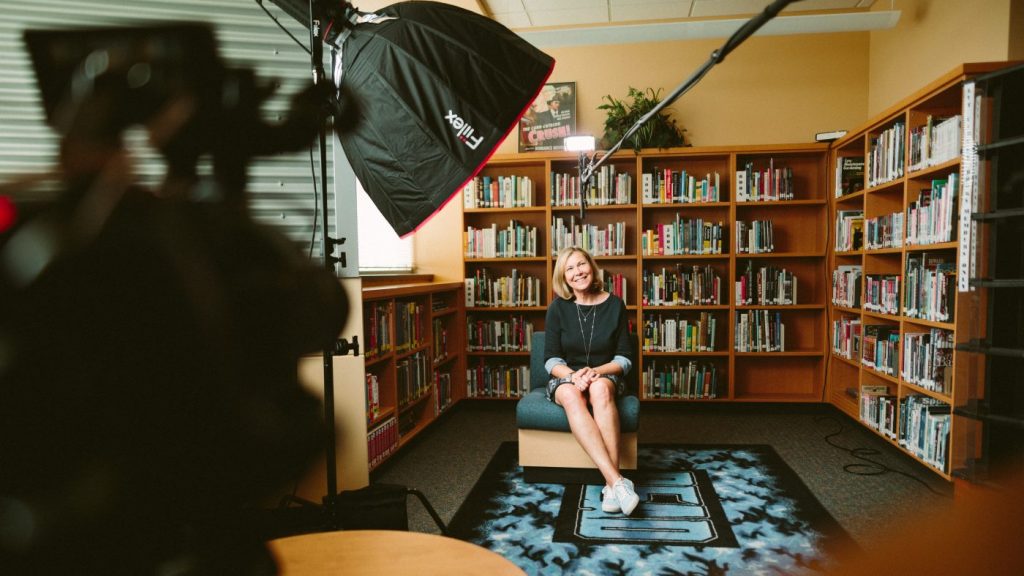
Yes, you read that right. Ok, so it’s not a premiere slot on Sky One or anything, but running your IGTV (and your YouTube, for that matter) like your own TV channel is a trend that’s starting to blow up in the video marketing world, as data shows that by 2020 we’ll be consuming more online video hours than we do traditional TV. That’s big news, and getting ahead of that trend right now could be quite a game-changer for the future of your brand.
Looking to kick your video marketing up a notch and start using IGTV? Get in touch with us – we’d love to put some of these ideas into action.

Video Marketing In 2019: The DHP Studios Whitepaper
15th January, 2019
2019 promises to be the most exciting yet for video marketing.
The following whitepaper – crammed with stats, predictions, debate and recommendations – is our great big effort to set your marketing plans and your business on the path to success.
Buckle up pal – this is gonna BLOW. YOUR. MIND.
2019 video marketing trends
Let’s start by crunching the numbers. Here are the key trending stats from the video marketing sphere you need to know to prepare for the year ahead.
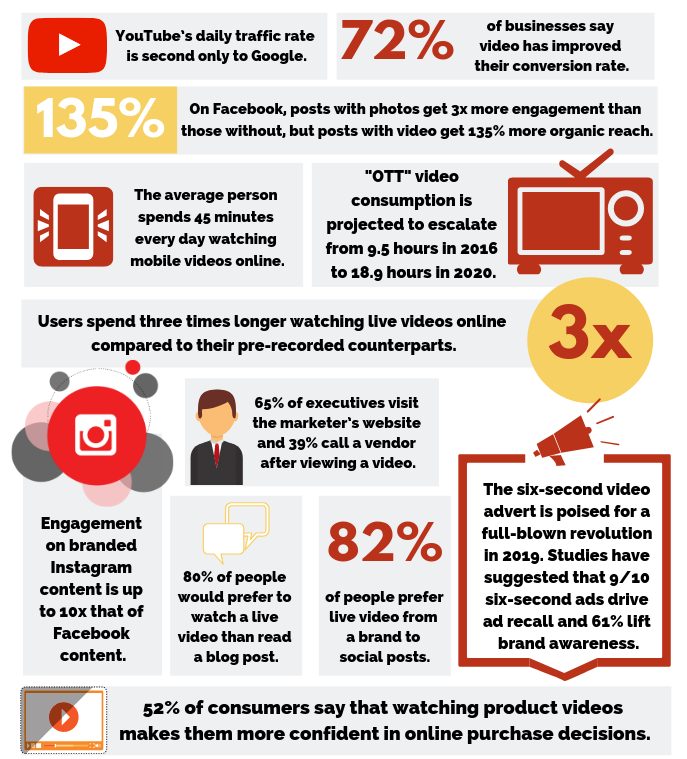
Strategy
A strategy is essentially how you implement your creative ideas, when you do it and where.
Take the time now to enhance your 2019 plans to make sure your campaigns and investments in great content are going as far as they can for you, otherwise you could find yourself burning through time and money with little to show for it.
Take a stand
One of the most groundbreaking events we attended this year was the infamous Tobacco Dock Festival Of Marketing. We learnt tonnes whilst there, but there was one golden thread running through each and every workshop:
“It is time for brands to take a stand.”
It’s true. In these politically dicey and divisive times, where our environment feels threatened and the future unsure, the people of the world have begun to place greater value on speaking up and taking a side – no matter who or what you are. Brands are very much included in this expectation, led in no small part by Nike’s controversial backing of NFL player, Colin Kaepernick.
By supporting Colin’s decision to kneel during the National Anthem in protest of racial prejudice in America, and subsequently siding with him and against the National Football League when he was released from his NFL contract, Nike turned the marketing and branding world on its head. The brave gamble they took here divided their worldwide audience, but the mere act of supporting this person by sacrificing a proportion of their market share for what they believe is the greater good has seen them come out on top. Now, the rest of us need to fall in line behind them.
So what does this mean?
It means gone are the days of burying your head in the sand and expecting difficult conversations to blow over. As are the days of timid marketing and people pleasing with no moral parameters. Those who make the grandest gesture and the most topical statement are the ones who win the race to brand recognition.
Serious food for thought there.
Having the right online conversations

This relates quite closely to the whole Nike/Colin Kaepernick scenario, but there’s an interesting angle here when it comes to strategising your marketing efforts.
Obviously, you can’t predict the topical conversations of the future. At least not without the help of a dodgy clairevoyant or Paul the World Cup Predicting Octopus (RIP). So how do you work the “right” conversations that haven’t happened yet into a strategy?
Well, your content strategy should be based around conversations that are already happening. You can find this in your search query report and your social media comments.The more divided opinions over it, the better, as it’s bound to bubble to the surface at some point and when it does, you’ll be ready.
If the conversation happens seasonally, or there’s something on the horizon likely to get people talking about that topic, then plan your content for release at the appropriate time of year. Otherwise; prepare it, bank it and keep an eye on the news…
Making space to go live
While we’re talking about plotting things into your schedule, make sure you are making time to go live on your social media channels this year.
Social media algorithms are programmed to favour live video. This is the result of content saturation endangering the sincerity and authentic connection social media can facilitate, and going live is not only quite personal, but to viewers it’s transparent and trustworthy. According to experts, almost half of live video is discovered via the news feed; a far greater natural exposure than your average photo post.
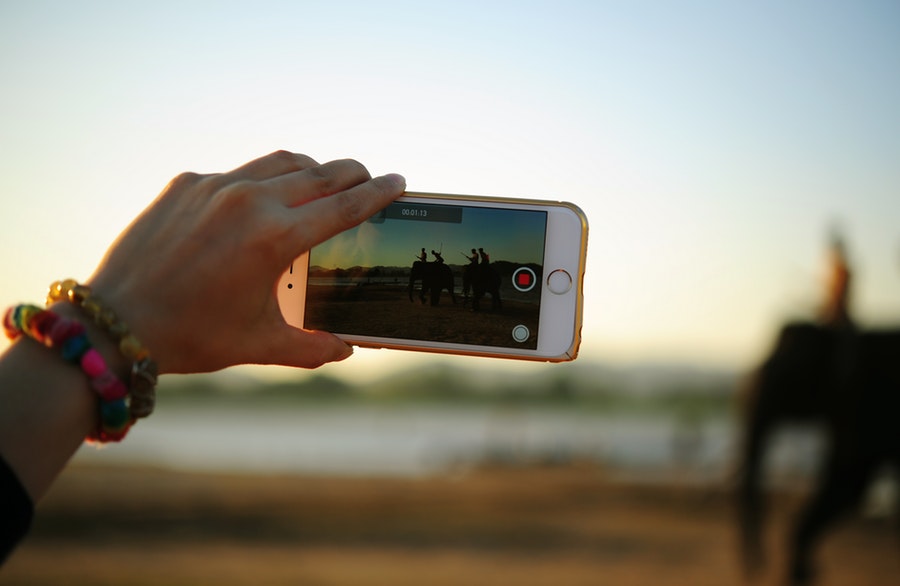
Just to really hammer home the need to include live video in your strategy, research even indicates that live video yields higher engagement and retains viewers for longer than pre-recorded video.
Production
Content for content’s sake will not cut it in the digital world, and the way yours stands about is by bold, tasteful and endlessly creative video production. As we see it, the digital marketing hierarchy goes like this:
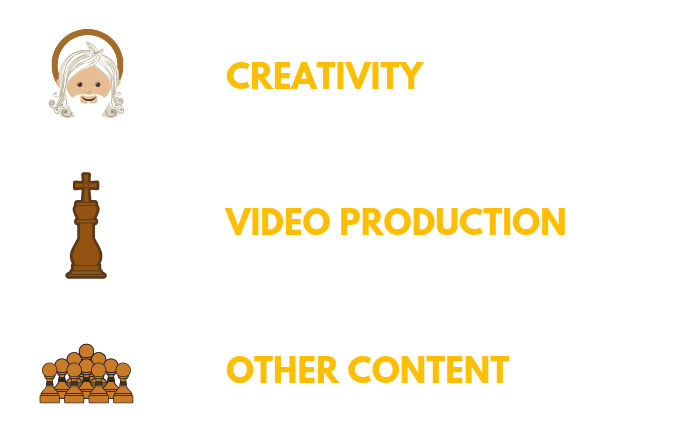
Video production has the upper hand no matter where or what you are marketing. But setting yourself up to conceive and create the ideas that make your video marketing (and consequential additional content marketing) succeed is a difficult thing to make practical in itself.
Through years of experience and a vast client roster, we’ve determined some key elements that’ll keep your video content prowess razor-sharp in 2019.
Lead your team in the art of storytelling
At DHP Studios, we’ve been called in on more than one occasion to help a struggling marketing team.
Not struggling in terms of competency, you understand, nor because of skill gaps or even lack of motivation. Goodness no. Often, the issue organisations are coming up against is the struggle to achieve succinct storytelling in pursuit of a sales or subscription goal. Silo working always plays a part in this struggle too.
In 2019, it’s more important than ever to be adept at storytelling.
The better your team are prepped to be creative in how you tell your story, and are helped to transition from a purely sales mindset to that of surprise, delight and clear, people-led narrative, the more successful your marketing will become. We are all interested in the story.

IRL is making a comeback
Sounds batty doesn’t it? But it’s true – In Real Life is very much making a comeback.
It seems we’ve finally come full circle. We’ve reaped the benefits of a digital world, realised the pitfalls, and attempted to re-establish balance my making and having stuff again. Pop-up shops are on the rise. Facebook launched a print magazine. The Army is recruiting selfie addicts. Tangibility and turning digital age behaviours into something more meaningful is very much in.
And what medium is perfect for showing people around the stuff?
You guessed it. Video.
If you’re working with a tangible product already, you’re very lucky. You can metaphorically and physically pull your product apart, tell its story and put it back together on video. Longer form video content gives you the opportunity to demonstrate how your product becomes the sum of its parts, whilst your other content can feed into that overarching concept by breaking down the many ways your product positively impacts your customer’s life. Not to mention let them explore how you physically built it.
If you can prepare a bank of content like this for a product launch this year, you’ll already have given yourself tonnes to talk about.
Case study
We did exactly this with Nike Sneakerboots.
Our ideas revolved around presenting the Nike SneakerBoot in the environment for which it is to be worn – the elements of Autumn and Winter. We demonstrated the burning out of old, simpler trainers and take the viewer on the journey of the SneakerBoot’s specialised layers, exploring each material and the shapes and textures they offer to the final product.
Embrace 360 video and Virtual Reality
You could, of course, banish the idea of IRL entirely and embrace a counter-strategy with another growing trend: 360 video and Virtual Reality. The key behind the growth of this trend, however, is often in the pursuit of viewing something to affirm honesty and transparency – particularly when it comes the the tourism sector and the idea of ‘try before you buy’.
Take people to where they might go, or – if you’re in the gaming industry – where they dream of going. Bring real world experiences to them, and you’ll earn their trust quicker… not to mention their custom.
…Oh, and shoppable content videos
eCommerce is experiencing some serious technological developments with the bubbling pot that is shoppable content.

By all accounts, this is the clickable feature that’s about to explode. Shopping in 2019 is going to be quick, easy and swipeable. The role of video here is clear, as 96% of consumers find videos helpful when shopping online, and placing a video on an eCommerce page increases the order value by at least 50%.
The democratisation of video
There is a strategic decision to be made here: should you invest in polished, directed videos? Or should you utilise newer, more developed phone cameras, save some cash and make do with homemade video?
The answer is very much going to depend on your budget and brand. But consider this…
Some reports insinuate that due to wider access and higher quality of phone cameras, video production standards have lessened. Whilst that may certainly be true in some respects (professionally shooting every single organic Story video, for example, is definitely overkill and only really needs to happen on your phone), maintaining a higher standard of video will continue to set your channels apart from the rest. Whilst attitudes may well favour cheaper DIY marketing videos, that also comes with a greater level of social media noise.
Accessibility doesn’t mean you have to lower your standards. Keep your look on-brand and professional and – by far and away the most important factor – focus on using video to tell your brand’s incredible stories.
Distribution
Without careful thought about the distribution of your mind-blowing content, you’re going to sell it short.
A thorough lesson in marketing funnels comes in very useful here, so if that concept has remained unfamiliar to you thus far it might be something to pop on your 2019 Self-Development Wishlist.
Meanwhile though, be sure that you have a good idea on the following points and you won’t go far wrong with your content distribution:
- Who can help you share your content?
- Which social media channels are your audience hanging out on?
- What other media are your audiences consuming? Get them listed and use these sources for targeting, as well as to identify extra distribution channels that may be of benefit to you.
Those three points build a great base for you to start thinking about distribution from. Add the following points and success is yours.
Utilise influencer marketing to the full
Spare some creative juice for your influencer strategy too.

Marketing through your own channels will only get you so far. Due to a fundamental mistrust in brands – particularly among the younger generations – influencer marketing has grown at an exponential rate over the last ten years. People trust people. Hence the importance of storytelling as discussed above, but also hence the limited impact that comes with concentrating every resource on your own marketing channels.
Engage influencers in the most meaningful, emotional and creative ways you can think of when you execute your campaign. Depending on who you want to collaborate with, this approach can be a slow-burn operation, and it’s time consuming (don’t worry, there are some great influencer marketing freelancers around to manage this process for you), but the brand endorsement you achieve when you do this right can really pay off.
Case Study
Towards the end of 2018, we had the pleasure of working on a creative video campaign with British Study Centres. With the goal of recruiting young people from across the world onto their English Language course, we used the influential command of their key collaborator: Manchester City FC.
We stuck to the forward-thinking mainstay of putting the people (in this case, potential students) at the heart of the story. Rather than using Man City FC players in the video – who are wonderful but would distract from the campaign objective – we boasted the influence of the location and the iconic blue kit. And then we turned our attention to a smart distribution strategy, with incredible results.
Within a month of going live, the total reach for our BSC Facebook ads totalled 327,000 people (so far). To break it down…
Overall Reach (people who saw the ad at least once) = 327k
- Overall 10s views – 65k
- Overall full views – 12.5k Full Views
- 548 Likes, 113 Comments and 163 Shares
In this instance, it was only helpful to have huge numbers watching if they’re going to follow through to the website. Objective achieved. BSC’s web traffic has indeed increased significantly:
- The City Football Language School web page has seen over a 104% increase in web traffic since the beginning of the Facebook ad campaign. This traffic is almost entirely coming from Facebook.
- We’re seeing a big rise in traffic from the following countries:
- Spain (+665%)
- Mexico (+2.5k%)
- Brazil (+300%)
- Referral traffic from the British Study website is also increased significantly with a rise of 7600%.
In one month, the perfect blend of influence, clever distribution and innovative video production obtained results beyond the clients wildest expectations.
Attention-grabbing Facebook ads
With the decline of Facebook reach (yes, we’re bored of hearing about that too) and ever-increasing content saturation, it’s more important than ever to be able to target the right audiences and captivate them through video, which experts predict will be the medium that sees the greatest growth rate on the Facebook advertising platform.

Because there’s advertising spend at stake and a growing number of confusing advertising options being offered up by the social media giant, your strategy is integral to your Facebook marketing success. And it’s worth doing well, because despite the number of times the death of Facebook has been predicted and even despite all of last year’s data scandals, no one’s really planning on ditching their Facebook profile any time soon. All stats are up year-on-year, including new signups, advertising revenue and daily active users. Those stats are true as of January 2019.
The takeaway here is simple: Facebook is too big to ignore, and there are some gaps in the market that could prove effective for you if you move quickly (see Sector Recommendations below). For now at least, you need to keep facebook advertising in your strategy, put your money behind video adverts, and keep them sharp.
Millennial Advertising
It’s been reported by Business Insider that to reach the under 35s, space for video adverts are being taken up on Instagram over any other channel… including traditional television. For this age group, as much as 61% of marketers will opt for the image-led platform compared to just 3% who target young people through TV adverts. YouTube was next most popular for youth ad space at 30%.

Meanwhile, the over 35s are keeping it traditional. The highest proportion of advertisers will still pay for prime time ad slots to reach this demographic, with Facebook coming up as the second most popular platform. Instagram trailed in at 3% of space for this age group.
Sector recommendations
General – Storytelling
Read to lead your team into a 2019 full of incredible story-based marketing? Some actionable steps towards leading a storytelling team include:
- Revising any marketing request forms that get submitted to your team so they lead with storytelling touchpoints.
- Put forward a report or proposal to make your ways of working more conducive to creative brainstorms.
- Lead cross-organisation Integrated Marketing Sessions.
- Work with video marketing and production agencies who’ve cut their teeth in the industry by working in this way (hiya!).
General – Have the right conversations
If you’re feeling ready to kick your brand’s conversation skills up a notch, try using the following tips to prepare for your stronger, bolder engagement strategy:
- Identify the questions you’re asked most on social media or the search queries that regularly need people to you. What do your audience need you to talk about that will make them converse with you?
- Carefully plan how you’d talk about a relevant but controversial topic on your brand’s social media channels. Where would be best to have that conversation? What’s the most meaningful, but reasoned and non-damaging way to debate this subject?
- Is your community management up-to-scratch? If you’re really going for this, do NOT underestimate how many man hours it takes to have level-headed conversations with the public without damaging your business reputation. It’s all about a careful balance with a good intention.
Education – Influencer marketing
Influencer marketing, the holy grail of endorsement! To start this ball rolling, you could:
- Take one of your 2019 campaigns and create an additional creative proposal on what you could ask influencers to do to really engage with your brand. The more interesting content opportunities you give them, the better the exposure.
- Source some extra budget to pay them (because they should be paid for doing your marketing for you). It’s possible to approach people who may want to engage for exposure, but that will be a harder process to maintain in the long-term. Plus, they have rent to pay. Let’s not be that guy.
- Drop us an email to make sure you capture their campaign activity for your own video. Use the production internally to prove the worth of influencer marketing to your stakeholders, and externally to target the influencer’s audience with an acquisition strategy. Don’t panic if that all sounds like gobbledegook to you – we can help you out there.
eCommerce – IRL
So let’s talk tangibility emphasis for second. With a little preparation, you can easily leverage this returning trend:
- If you work in a product-based company, you can thank your lucky stars because your job is half done. Your challenge is to work out how to kick it up a notch when is comes to displaying your product. Pull it apart and brainstorm what you can show your customer. What genius invention could they hold in their hands if they come to you, and how will it enrich their life? Step up every touch point and use video marketing to show them exactly what they’re missing.
- Service-based business have a trickier feat, especially those in the charity sector. There are ways around this difficulty though, particularly by taking into the account the possibilities that animation brings to the table. We published five reasons animation may be the way to go for your next video campaign, and this approach has paid off for many of our service clients, including Teenage Cancer America, Wellcome Trust and The National Maritime Museum.
Travel – VR and 360 content
This content type requires more thought than others, but you can do this. Make a start by:
- Considering a phone upgrade or an investment in a dual camera. You can’t take 360 videos without one.
- Try Facebook 3D pictures. Undertake a couple of tests with your dual camera. Pick a smaller space to show your audience in this new format, and ask what they like/dislike about it. Use the feedback to take better 3D photos until you’re showing the audience exactly what they want to see. At this point, you have a baseline for consistency that you can build on for bigger, richer engagement with every post.
Entertainment
Across all the social media platforms that have them, the Stories feature is currently the most under-utilised advertising opportunity, making them ripe for better exposure than advertising in the newsfeed, and higher ROI.
Considering the brief and creative nature of stories compared to the longer-form and often more serious nature of posts in the main newsfeed, it’s a logical assumption that paid placements in Stories are best utilised by the entertainment sector, as the viewer is often there to consume lighter content.
If they move quickly, entertainment brands can implement a strategy that harnesses this opportunity. We’d recommend taking the following next steps pretty soon…
- If you haven’t already, create yourself a schedule for organic Instagram Stories and stick to it. Getting your existing audience used to you using Stories and being able to leverage an existing following through them will provide better data (enabling strategic pivots to your advertising plan) when you start your first advertising campaign.
- Dive into your target audience. The more you can learn about the profile of your target demographic and develop a marketing persona, the better your advertising targeting will be, ensuring your spend is put to good use on the right people.
- Video continues to be the best performing content type within Stories, but it’s a double edged sword. The pressure is on for that one video to capture your viewer’s attention, tell a story and deliver a memorable call-to-action in just a few seconds, which is no easy feat. Plan this thoroughly and don’t leave it to chance. Or give us a call, obviously.
Sport
So it’s official, we’ve almost overtaken the amount of time spent watching traditional TV with hours spent consuming Over The Top (i.e. internet delivered) video. Given the huge amount of reach and influence YouTube has, it makes sense to draw some inspiration from traditional TV methods by the simple act of planning for consistency and familiarity. Sport is the perfect sector for this – if executed well, the range of topics is diverse enough to cover in the form of mini ‘TV’ shows whilst still being intrinsically linked to the umbrella topic of ‘sport’. Try this:
- Schedule, schedule, schedule! Though traditional TV hours are decreasing, the concept of the schedule will undoubtedly help your channel succeed if you stick to it. Throughout this whitepaper, trust has been mentioned a lot. The act of simply choosing consistent publish days and times for your YouTube videos will offer potential fans an olive branch, allowing to get comfortable with you. Let them know what to expect, and deliver.
- Continuing the theme of getting comfortable, establish content buckets. Jessica Zweig has a brilliant blog post on exactly how to do this. If you can bucket your channel’s content, you ensure you stay within a range of topics your audience want to hear about, rather than going off-piste and boring them, which should secure those all-important returning visits.
And there it is – our 2019 video marketing whitepaper. If you want to chat through anything further, ask a question or just tell us you like our shoes, feel free to drop us a line. Here’s to 2019!

5 Reasons Animation Works Better Than Live Action For Your Charity Video
12th October, 2018
From experience and through our heaving little black book of contacts, we know charity video campaigns are not easy to pull off.
With budget often being a highly contentious issue and subject matter being particularly sensitive to cover in a matter of mere seconds, there are many hoops to jump through at the planning stages of any charity video.
One of the key choices you’ll need to make at the beginning of this process is whether you opt for a live action video – that is, a full scale video shoot complete with camera crew, director and actors/beneficiaries – or whether the medium of animation can better help you communicate your message.
There are pros and cons to both, but we know considering animation can feel particularly overwhelming if you’ve never managed that kind of project before. Check out our five reasons why animation could be right for you. What will you decide?

1. Costs
Don’t get us wrong: good animation does not come cheap, and animators should charge a healthy amount for the very hard work required for those videos. But it can often turn out to be a cheaper option. There are a few reasons why:
- Start to run through the sheer amount of people required on a real life video shoot in your head. Between staff, cameramen (because you’re going to need more than one for a video that has any kind of depth), a director, actors, extras, venue chaperones… and those are for a relatively simple video. Can you imagine the amount of time that tots up if your shoot goes on for more than a few hours? That’s a lot of day rates and a lot of staff time. Now compare that to the day rates of a couple of animators. We can hear your bank account sighing with relief as we type…
- It’s rare that a venue will let you film in their space for free, whether you’re a charity or not. At the very least you’ll probably be expected to cough up a donation. Animators need no venue, other than the one they are drawing.
- If you’ve got a very specific vision, even the very best cameraman may not have the exact kit to cater to every client’s creative ideas. Some may purchase what’s required for the desired effect as it’ll benefit them in the future, but if your idea is so unique that there’s not much call for it, you’ll probably need to foot the bill for that particular bit of tech. This is generally avoided by using animators, as the medium is more simplistic (but effective).
- Everyone is going to need sustenance, or at the very least a hefty amount of snacks and bottled water to keep their energy up throughout the day, which you should really be providing (and works out easier if these are onsite, as even the best planned shoots get squeezed for timings). Hello expenses!
- Realising you need to re-shoot a scene is not the nicest realisation you’ll ever come to, but human error can arise and sometimes it’s required. This can add quite a few extra notes onto your bill that you hadn’t really been prepared for. Meanwhile, an animator can make an urgent edit at a fraction of the cost of a re-shoot.
2. Animation helps put the charity’s cause at the forefront
While live action videos can be truly wonderful (we should know, we’re responsible for so many that are out in the world!), unexpected elements can be distracting from the point of the film. This is something charities in particular will want to avoid, as of course the focus in any charity video must be the cause.
The last thing you want is to open the audience up for judgement (isn’t she in that TV show? He’s devilishly handsome! Was that the dog I saw on the train this morning? Why does she remind me of mum so much? Why choose THAT sweatshirt?) when what you want them to do is learn how they can help you changed the world.
Taking away much of that unfortunate but natural human judgement is a terrific way to keep the audience concentrating on your message, rather than details that give your message little headway.
3. Animation can enhance your branding
In much the same way that it can accentuate your message, animation can enhance your unique branding, offering more options to make it ‘pop’ or to create entire worlds where your logo and colour palette is king. When done well, this is a really effective way to increase brand recognition.
This also feeds through to other deliverables like social media posts, toolkits and more. By using the look and feel of your main animation, the options for your deliverables are not only linkable to your brand but are made controllable and flexible for maximum impact throughout your marketing distribution.
4. Animations avoid authenticity issues
We’ve all seen those cringey Netflix documentary reenactments played by well-meaning but often completely offbeat actors. These often miss the mark because the video is low budget, and the actors voluntary or low paid.
We do completely understand that needs must. And not all of them are terrible. But if you’re a charity dealing with a particularly sensitive cause – especially ones that negatively affect people’s lives – the finished result is in danger of being wildly unsuitable for broadcast. And that would be a shame on many levels.
Animation avoids issues that you could face with live action coming across as inauthentic.
We should note here that yes, animation can also make telling a human story hard. But this important element can be reinstated by focusing on how the tone of voice, voiceover artist and music enhances the video. Not to mention…
5. Animation can express more abstract ideas
From timeline jumps to show a result or demonstrating what life could be like after interacting with your charity, animation suspends reality. So whilst you might want your narrative and storyboard to be as convincing as possible, and relate back to human experiences you know people have had, animation allows for condensed timelines and exaggerated emotions to make greater impact. This can be achieved with a live action charity video, but it requires very good actors and high quality effects.
So, what’s the verdict? If you get the feeling animation might be the way for your next charity video campaign (or, indeed, if you’ve concluded that you need live action and are looking for a devilishly handsome agency to deliver it for you), drop us a line today. We’d love to talk about how we can help!

3 Clever Ways To Enhance Your Commercial Video Using Music
30th July, 2018
We’ve spoken in depth about getting the best from your video production in terms of idea conception, the film set, film content and much more. Many video projects will require dialogue to get the point across, particularly in demonstration and ‘how to’ videos, and almost every video ever made will be enhanced by music. Music can be the key element which adds professionalism and polish to your commercial video. So with that in mind, we are going to look at three ways to enhance your commercial video using music.

A note of caution before we continue! Although there is copyright-free music available out there, you need to be absolutely certain that you have permission to use any music you choose in your video production. In brief, if you want to use a commercial song in your video, you must obtain two licenses – a synchronisation license to use the song and the master license to use the recording of that song. It’s a big and tricky subject that we don’t have space to cover here, but a master license will need to be obtained from the record label (or from the artist themselves in the case of independent artists) and a synchronisation license will need to be obtained by the music publisher. Whether you’re looking to enhance your commercial video using music or using it in a non-commercial project, for your own company or on behalf of clients, you need to make sure that the use is legal. A further element to keep in mind is that licensing music early in the project could curtail the chances of a budget issue later.
The Bookend Approach
We’re pretty sure that everyone everywhere has watched a video where the music throughout was distracting, if not irritating, for being too loud, the wrong pace, out of context with the video content or purpose or worse.
Depending on the type of your video project, you may find that music simply isn’t needed through the whole video. A corporate video or film, for instance, may actually benefit from having only short bursts of music or a bookended approach.
Often music can actually be more powerful when it is used intermittently – it can better accentuate a point or a climax in the video. When music is forced throughout, the viewer may get tired or bored. The bookend approach gives the viewer some breathing room and this can allow the environmental and background sound to help shape the audio of your project.

If you are going to use a bookended approach, it’s a good idea to pick one music track or theme to open and close the video, especially on shorter video projects.
Giving music or sound design a featured role in the opening and or closing sections of your video will help to set your tone, hold your message together, and leave your viewers with a feeling of completion. A way to do this is to pair music or sound design with an image for three to five seconds.
Using bookend music, or simply turning up the volume of the music at certain points, can also be used to divide your video into chapters or segments.
Music Throughout
While video images are great, the music in your video can really help to stimulate your audience and set the mood/tone.
Essentially, music is entertaining enough in itself that, when in the background, it can keep us focused even on otherwise un-entertaining things.

In choosing music for your video, and to truly enhance your commercial video using music rather than turn the audience off, you need to consider your target viewer. What’s their age, background and interests? Whereas an executive of a blue-chip corporation may not identify with hard rock or hip-hop, this may be a perfect style choice for a younger audience. If you’re trying to reach a broad market or many age ranges, look for music that has a broad appeal; you won’t want to alienate or dis-engage your audience with anything too genre-specific.
You will need to decide what role music will play in your video; whether the music supports or drives the message you’re hoping to convey. If your audience notices the music too much, it could be pulling away from rather than adding to the overall impact. Be clear about whether you are conveying broad information or if you are trying to impart technical details that your viewer will need to focus on without distraction as this will dictate what kind of music you should use. Detailed technical info should have a supportive underscore that doesn’t pull the attention of the viewer, but if you’re trying to convey broad concepts, then you’ll need foreground music that evokes greater emotion.
When choosing your music you’ll also need to decide whether or not to use vocals.
Vocals under dialogue or an interview can be distracting and off-putting, but if chosen carefully they can also carry your message through, and can sometimes add some humour, if appropriate to the theme. If you choose a vocal track for your project you must work out whether or not the words support what’s happening in the scene/video. Good non-vocal tracks can often convey the same emotions without words and in many cases could be considered a safer bet.
Music Without Dialogue
Video marketing relies on ensuring your music is the perfect fit for your campaign, brand and product. But what about the idea that your video features nothing but music?

One of the added bonuses of a music-only marketing video is that they make great content for social networks that auto-play videos which don’t have sound to begin with.
When we’re scanning through our social media we may not always be in a position to have audio with the video’s that come up (i.e. in a hospital or at a conference – little bit rude that one, you should be listening to the speaker, but you know what we’re saying) so you can assume that your prospects may be hearing nothing at all when they catch your video on Facebook, for instance.
Videos that feature only music and have no narrative or sound effects need to be compelling enough visually to draw people in without the promise of dialogue, and this effect must be achieved with or without the sound. Of course, you need to add music which will capture the imagination of the viewer if the sound is on, but keeping in mind that often it may not be. The old silent movies are an excellent example of how this can work.
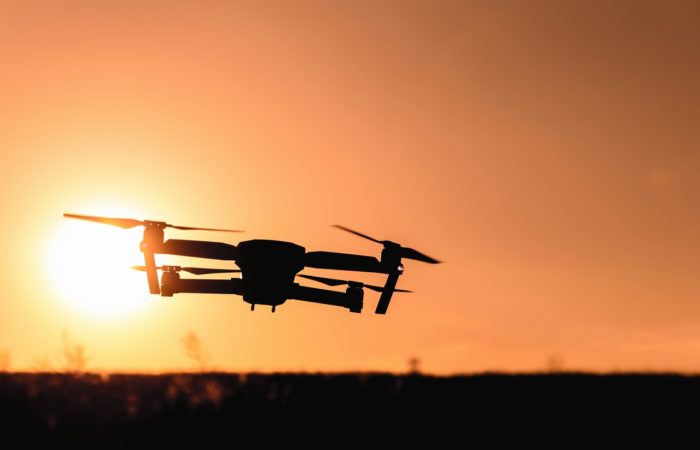
5 cool uses for drone video footage
20th November, 2017
Before drones came along, aerial filming and photography was not an easy thing to get hold of.
Gone (well, nearly) are the days of hiring a helicopter or light aircraft and a pilot, waking up in the morning to heavy rain or thick fog, rearranging the flight for another day, waiting for availability again, only to find that you wake up once again to inclement weather… and start all over again.
The Age of the Drone means you don’t need vaults of cash to pay the day rate of a pilot. Quite the game-changer.

In the event of bad weather, we can just land our drone until the wind and rain eases off. Or – joy of joys – just take it out for an hour if there’s a small window of sunshine, and pack it away again when the clouds come back.
What we’re saying is, with the help of a drone license and a bit of camera savvy, it’s easier than ever to capture aerial video footage, and save the clients who need it a whole lot of precious time and money.
Drone video captures the true size, shape and layout of locations on the ground, whether it’s buildings, landscapes, events or sites. A drone can tell the same story that photos or traditional recorded footage can tell, but better.
Footage is well-documented in its ability to increase time spent on web pages, and drone video can help your video content stand out from the crowd in social media feeds. It’s a worthwhile investment.
Here are 5 ways to use drone footage for your video marketing needs, but this is by no means an extensive list. The potential is endless.
What you need to know
Whether you’re thinking of investing in your own drone equipment or hiring a company to produce your video footage for you, these are the things you need to know:
- You need a qualification for flying your drone.
- You need permission to fly from the UK Civil Aviation Authority.
- You need Public Liability Insurance.
- You need to check the credentials of anyone whose services you use to produce drone footage. For the record, ours are tip-top…
Sunrise and sunset

In terms of lighting there is a ‘magic hour’ just before sunrise and just before sunset, when the light is soft and mellow and even. With a low sun there’s no harsh glare and no awkward shadows – this is the time that drone footage comes into its own.
Quite apart from the lighting benefits of the ‘magic hour’, sunrises and sunsets are great to use in video footage – they can be used as a glorious backdrop to your message or product or as a metaphoric interpretation of light and dark, growth, life and death and so on to add symbolism to your messaging.
Behind the scenes in the office
We’ve explored before the ins and outs of filming in the office environment, and the drone is a fabulous way to get some great behind-the-scenes video of your working environment. It provides an overview which can be very interesting to the viewer, giving a sense of being a part of what’s going on.
Scenic locations
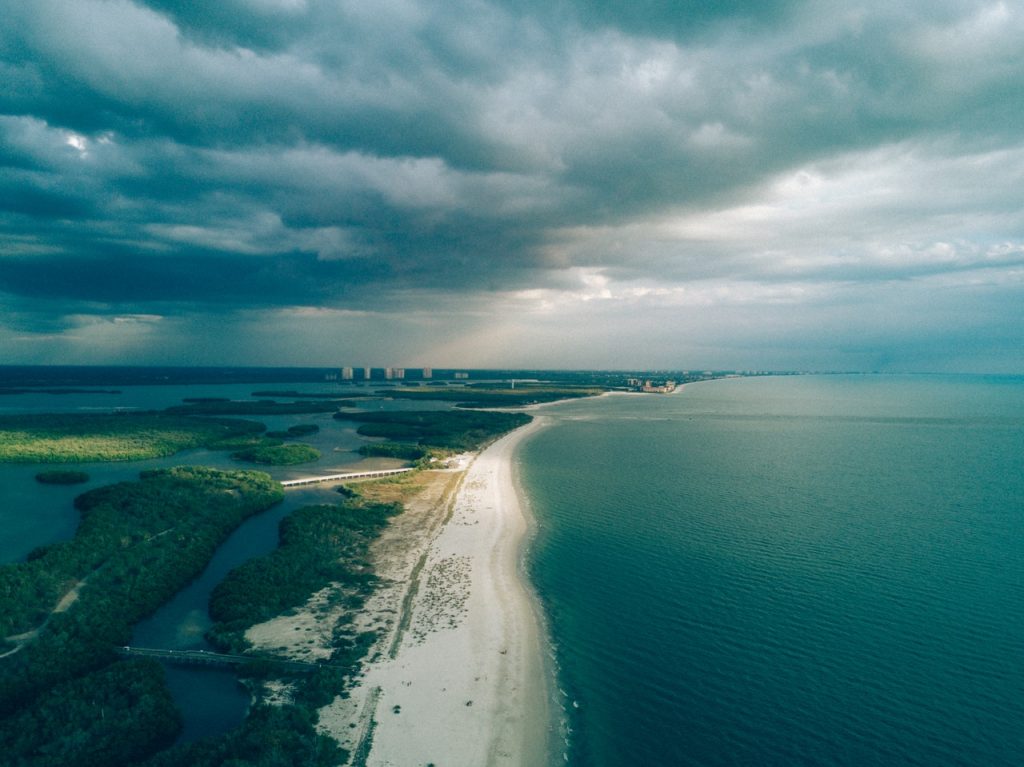
Scenic locations are put into a great perspective when filmed using a drone.
Whether you’re offering a sense of place, or your product is ‘the place’, drone footage is the way to go. Your office could be in the centre of a city or in the wilds of Scotland; there will be an amazing amount of interesting buildings, landscapes and features around you that will give your customers a sense of where you work and how your surroundings feed your creative soul.
If your workplace and product is a feature. like a vineyard or a brewery (how we would love to work in a vineyard or a brewery!), then your video will allow your product and the place it’s actually produced to shine.
Festivals and events
One-off events, festivals, fetes and fairs can deliver great footage for your promotional content. The colourful, carnival atmosphere can be hugely engaging for the viewer, and provide seasonal content that sets you apart from others (think christmas markets, sports competitions, etc).
If you regularly display your wares at events such as food and craft fairs, regattas (water-based events) or music festivals, you have a ready-made barrel of material just waiting for you to capture it!

Groups and awaydays
If you can safely say your office space is the most boring place on earth and your boss has all the camera appeal of a landfill site, the best thing that you can do is to decamp and get the team outside.
Organise a team awayday or bonding sessions (preferably not in the pub for this one) and order in your friendly video production agency to capture all the loveliness on some drone footage.
Even if all you can do is gather them for an aerial group shot, you have unique footage to incorporate into your marketing materials.
Go live
The great thing about drone video is the capacity for a real-time ground image feed – live footage, as it happens, being produced for instant streaming and viewing.
Following on from the dashcam and the GoPro, the drone is producing a bird’s eye view of life as it’s being lived. It’s incredible.
Tempted to jump into the world of drone video? We might be able to help you there.

We brainstormed 10 types of brand video so you don’t have to
6th November, 2017
Ok, so you’ve decided that video is the way to go to make the world aware of your brand, and you’re in good company. If you can make a video that goes viral with your brand featuring in it, well, my friend, then you’re golden. But how? What makes a social person want to click, watch and share your video?
In truth, the answer to that question is probably puppies and kittens, babies and humour (all 4 of those together is dynamite!). These things trigger a natural reaction in the world of social media that people to want to share with their friends.

So, where does this leave us in terms of your brand video? We’re going to throw out there 10 ideas for video use that promotes your brand to get you thinking. Check these out, see what you think could work for you.
Company Specific
This is your video outlining everything about your company – your vision, your mission, your product, your services. It’s laying it all out there on a white tablecloth for the world to enjoy. How you do it comes down to what the company does, this is where your creative team take up the challenge (just don’t forget the puppies and kittens, babies and the humour!).

The origins of your product will place it in the public’s minds; share the story and the history of your brand with them.
Case studies & Testimonials
These are a great way to showcase your business and its strengths. People love stories about people – the video that connects people to your business, real people, is powerful and compelling and sticks in people’s minds. Real customers and advocates of your business telling their stories is a great way to showcase your brand.
Demonstrations
Demonstration videos of your product or service – or ‘how-to-do-this’ videos – are a brilliant way of creating reassurance about your brand, instilling confidence in people that you are the expert in this field.
Is there anyone out there who has never yet been faced with an unsolvable problem and hasn’t googled “how do I do this?” We think not!
Live Video
If you’re going to go out and doing something, then video it! Why wouldn’t you?
If you regularly attend events, host live displays, take exhibition stand space, cook great food in a kitchen, fly a hot air balloon, play football….the list is endless. Film it, stream it, and put it on the digital platforms of your choice.
TV Commercials
If you have the budget for TV, and you can come up with a great video, there’s no doubting that you can get your brand out there.
In truth the impact of TV commercials is on the decline with so many of the audience able to skip through the adverts, but then it always was the time to nip out to make a cup of tea or a sandwich. It’s certainly worth checking out.
On the flipside, clever and personalised content placed on catch-up players (for example; 4OD or the ITV Hub) can make headlines.
It’s certainly worth checking out, but make sure you know what you’re doing with this one.
Social Media
Videos made specifically for social media can be a wonderful thing. Add humour, beauty, quirkiness or content unsuitable for mainstream TV (or puppies, kittens…) and you have a chance that your video will go viral.
A great benefit of the social media video over TV commercial is the length, you’re not restricted to packing your punch into so short a time, and the speed in which EVERYONE could see your video is phenomenal. You really can be an overnight sensation.
Charitable Causes And CSR
There are unlimited great causes on this Earth and your brand may be an ideal way to tap into the ‘Save the World’ culture.
It may seem cynical to run a campaign promoting your brand on the back of the planet’s misfortune but it is a consideration, and if it is right for your brand then why not? A story for a cause can evoke a really emotional response in your audience.
The (really big) Thank You
In a way this is a slight return to the Testimonials above, but there is mileage in video of your customers and clients saying ‘thank you’ to your company for a great job well done.

This also works in reverse; there’s an opportunity for your company to say ‘thank you’ to your clients in video footage for a great project and outcome – highlights of the project could be recorded throughout the project and edited accordingly at the completion.
More Live Video
No, we didn’t run out of ideas for subheadings here, it just is the same thing but different.
If you can incorporate your brand into live footage of amazingly, stunningly, jaw-dropping visual content, then do it. Polar ice caps, tropical rainforests, meteor showers, anything that really takes the viewer’s breath away. And how much fun would that be to be a part of? (Lots, is the answer.)
Animation
It’s a mainstream option, but animation can be a great way to get your message across. Look what Wallace and Gromit did for Wensleydale cheese. Need we say more?
When uploading your video to your chosen medium, remember to make sure that you have the best keywords in your titles and the right tags to increase the search volume. Produce video content in sufficient quantity to maintain your brand awareness and to keep your story fresh. You’ll reap the rewards from it.